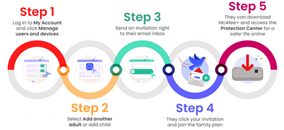
In our fast-moving digital world, today’s conversations can take on new meanings years down the line. Then you might find yourself explaining posts that no longer reflect who you are.
This reality makes it crucial to start a conversation in your family about social media archives. Teens and tweens are constantly posting, snapping, tweeting, and commenting every day. According to the latest research, 97% of teens go online daily, with many saying they are “almost constantly” connected.
With so much activity, it’s just a matter of time before some questionable content resurfaces, potentially compromising a job, scholarship, or personal relationship. Old social posts don’t just haunt celebrities; in today’s digital culture, everyone’s online activity is open to scrutiny.
1. Vet your content. Ask yourself some key questions: Is there anything in this post or comment that could hurt me in the future? Does this post defame a specific race, religion, or lifestyle? Is this content contributing to the conversation or just noise?
2. Be Careful with Humor: Not everyone shares your sense of humor. What seems funny today could be viewed differently in the future. Just look at how comedians and public figures are often held accountable for jokes or comments made years ago.
3. Don’t pick at it—purge it. No doubt, people change. You may not be the 20-something hothead who began tweeting or blogging nearly a decade ago, but your archives are still out and say otherwise. In her book, The Life-Changing Magic of Tidying Up, Japanese cleaning consultant Marie Kondo takes tidying to a whole new level, some of which we can apply here. 1) Don’t analyze everything and just pair down — purge. 2) Get rid of anything that doesn’t spark joy for you 3) Don’t ask yourself what you like about a photo or post, ask yourself ‘Why should this stay?’ 4) Keep only the content that makes you happy or inspires you. Chop everything else.
4. Use X’s advanced search. Some of us have tweeted out several novels worth of content. Who has time to go through that? Twitter has advanced search features that will help you quickly find questionable tweets. Just go to https://twitter.com/search-advanced and enter keywords and phrases, along with your user account name. This search will help isolate tweets that could be compromising.
5. Am I being true to who I am? Most tweens and teens are not asking themselves this question, but we can still encourage our kids to engage in this specific self-reflection. Encourage young publishers to think about what message and image they hope to project to go through their archives with that in mind. Encourage them to review everything about their profiles from their bio to the kinds of movies and books they’ve called out, to their Facebook groups. Ask: Is this still who you are? Are these still the interests you’d like to project?
6. Delete immediately:
7. Review likes and post privacy settings. Even the posts of others (that are marked public) that you like or comment on will show up on Google, which means others could judge you guilty by association. It may be time-consuming, but you can clean up your Facebook ‘like’ history in the Activity Log. If you want to share but still limit who can view your posts, McAfee’s Social Privacy Manager helps you adjust your social media privacy settings based on how public or private you want to be online.
8. Google yourself. See what comes up. Be sure to check images, videos, news, and more tabs. You just never know what content will make it into remote circles. If you find something surprising, contact the site host and request they remove the content.
The post Could Your Social Media History Come Back to Bite You? appeared first on McAfee Blog.

Kids engage online far differently than adults. Between group chats, social apps, and keeping up with digital trends, their interests, and attention spans constantly shift, which means online privacy concerns get sidelined. Here are a few ways to move online privacy center stage.
Few things will put kids to sleep faster than talking with parents about online stuff like privacy. So, flip the script. Talk about the things they love online—shopping, TikTok, and group chats. Why? Because all that daily fun could come to a screeching halt should a bad actor get a hold of your child’s data. Establishing strong digital habits allows your child to protect what they enjoy including their Venmo account, video games, and midnight chatting. Doing simple things such as maximizing privacy settings on social networks, limiting their social circles to known friends, and refraining from oversharing, can dramatically improve digital privacy.
We say it often: The best way to keep your kids safe online is by nurturing a strong relationship with them. A healthy parent-child connection is at the heart of raising kids who can make good choices online. Connect with your child daily. Talk about what’s important to them. Listen. Ask them to show you their favorite apps. Soon, you’ll discover details about their online life and gain the trust you need to discuss difficult topics down the road.
According to the latest Data Breach Investigations Report (DBIR), which examined the state of cybersecurity in 2023, some 68% of global breaches, regardless of whether they included a third party or not, involved a non-malicious human action, such as a person making an error or becoming a victim of a social engineering attack. For that reason, consider putting an extra layer of protection between your family and cyberspace. A few ways to do that:
A good digital offense is the best way to guard yourself and your family against those out to misuse your data. Offensive tactics and habits include using strong passwords, maximizing privacy settings on social networks, using a VPN, and boosting security on the many IoT devices throughout your home.
Get in the habit of deep cleaning your technology and bring your kids into the routine. Here’s how:
It’s hard to slow down and get serious about online privacy if you’ve never experienced a breach or online theft of some kind. However, chances are, the dark side of online living will impact your family before long. Ready to go deeper? Dig into these cybersecurity tips for every age and stage.
The post How to Get Kids Focused on Their Online Privacy appeared first on McAfee Blog.

Smart speakers. Banking online. Location tracking. If you are a senior adult, there’s no doubt, the digital leaps and bounds you’re asked to consider each day can be daunting. If you are the child of a senior adult trying to make digital life more accessible, helping your parent consistently stay safe online can also be a challenge.
According to a recent Pew study on the topic, senior adults continue to become more digitally connected, but adoption rates continue to trail younger users, and digital divides remain. The study also revealed that 77% of older adults needed assistance in learning how to use technology.
As a senior, it’s easy to feel intimidated and even try to avoid technology altogether as a safety plan. However, more healthcare, banking, and retailers become almost 100% digital, opting out of digital life is becoming impossible.
Still, there’s a way forward. As with any challenge, it’s best to begin one step at a time. First, put your stake in the ground by committing to increase your awareness and consistency in the digital realm. Doing so will help you reduce your fear about potential data breaches, malware attacks, or worse, falling prey to an online scam. Here are seven more ways to build upon your privacy path.
Online protection software safeguards your privacy while also looking after your privacy too. McAfee+ Family plans include personalized protection for each member of the family, including older family members outside the home. For example, a grandparent can set up and manage their own protection for their identity, privacy, computers, and phones. And inviting a grandparent onto the plan is as simple as sending an email.

Updating your passwords regularly is an online privacy gamechanger. The only problem? It’s tough to remember all those passwords, so who wants to risk changing them, right? Consider a password manager (find the software packages that have a password manager built-in). Your Password Manager (PM) stores then populates the username and password fields every time you log on to a favorite site or app. Better yet, it makes changing your password an easy task since you don’t need to do any remembering—your PM does it all for you.
What in the world? 2FA sounds complicated! Don’t worry, it’s not. Opting for 2FA means that before logging onto your account, you will have one more step to verify it’s you logging on. When given this privacy option, take it. Commonly, the 2FA process is a code generated by a smartphone app—no biggie. If you want to try, go to your settings in your favorite apps, such as Google or Facebook, and turn on the 2FA option.
Along with strong passwords, updating your software is a front-line defense against identity theft and fraud. Installing software updates (those pesky pop-up notices that are critical to your privacy) is essential in securing your IoT devices, PCs and phones, and the social media, banking, and healthcare portals connected to them.
5. Use a Virtual Private Network (VPN).
If we could write this one tip down a hundred times without losing our readers, we surely would. Every senior adult needs a VPN for practical, powerful privacy protection and peace of mind. A VPN keeps credit card and personal info contained in a secure network and away from prying eyes.
Fraudulent emails connected to fraudulent websites can look very legitimate. A secure website will have an “HTTPS” in the browser’s address bar. The “s” stands for “secure.” If the web address or URL is just HTTP, it’s not a secure site. Still unsure? Read reviews of the site from other users before making a purchase. Never send cash, cashier’s check, or a personal check to any online vendor. If purchasing, always use a credit card in case there is a dispute. Stay up-to-date on scams that target seniors specifically. Lately, elder scams have been constructed around COVID, dating apps, tax returns, employment, and, of course, the common military catfish scams.
Like it or not, companies gather, share, and sell plenty of information about us online. Among them, online data brokers that collect information about people from public records and third parties, like shopping information from the discount cards we use to get deals at the supermarket or drug store. They compile this information and post it online for anyone to see, for a price. And they’ll sell it to anyone. That includes marketers, advertisers, and even bad actors who use it for scams and to help them commit identity theft. You can clean up these digital breadcrumbs, though. Our Personal Data Cleanup scans some of the riskiest data broker sites and show you which ones are selling your personal info. We’ll also provide guidance on how you can remove your data from those sites and with select products, we can even manage the removal for you.
When trying to boost your digital skills, don’t forget about all the amazing instructional content at your fingertips. A quick search of YouTube will render easy-to-understand videos on how to do just about everything (including install security software, change your router password, secure the smart devices in your home, and how to adjust your privacy settings on any device).
Learning or building a new skill isn’t always easy, but if you stop to think about it, as a senior, you’ve gained so many skills over your lifetime (far more than your juniors). So, practically speaking, building up your tech skills is one is just one more task to ace. So, lean into the challenge, have fun learning, and don’t hesitate to ask for help if you need it.
The post 7 Savvy Ways Senior Adults Can Safeguard Digital Privacy appeared first on McAfee Blog.

Roblox, an online platform that hosts millions of user-created games, has become increasingly popular among young people. Its reported 150 million users can not only play games but also design their own, share them with the online community, and even earn money if their creation becomes popular. This has made Roblox an exciting and engaging platform for kids and teens, many of whom have the site downloaded on their phone, tablet, PC, or Xbox.
What sets Roblox apart from traditional gaming platforms is its social networking aspect. Users can chat, meet up, and even host private events like birthday parties. During the quarantine period, Roblox became a vital tool for social interaction, providing a virtual space for users to host private birthday parties and other social gatherings.
→ Dig Deeper: Study: Fortnite Game Becoming the Preferred Social Network for Kids
Like many other online platforms, Roblox poses certain safety concerns that parents need to be aware of. While Roblox itself is not inherently unsafe, its open chat feature and the potential for contact with strangers can pose risks. It’s therefore crucial for parents to take time to optimize parental controls, monitor their child’s usage, and engage in open dialogue about online safety.
One major concern is the potential for contact with strangers. Although the “Chat & Party” feature allows easy communication between users, it also opens up the possibility for unwanted contact. Adjusting settings to restrict strangers from friending an account is one step towards ensuring a safer experience for your child on Roblox.
Online predators can be a real concern when children use platforms like Roblox, which allow for social interactions and communication with other users. These individuals often use deception and manipulation to exploit the anonymity provided by online platforms. They may create fake profiles and pretend to be fellow players or peers to gain a child’s trust. Once trust is established, they might engage in inappropriate conversations, request personal information, or attempt to groom children for more harmful activities.
Alongside the potential risk of contact with strangers, several other safety concerns exist on Roblox. One significant concern is cyberbullying. As users can join any game at any time, the platform could be a breeding ground for online bullying. Parents should discuss with their children how to handle inappropriate chats and comments, and they should be aware of how to report any rule violations on the forum.
Online scams and phishing attempts are also prevalent risks that can compromise a child’s safety and digital well-being. Children should be educated about the common tactics employed by scammers and phishers, which can include fraudulent free Robux offers, fake giveaways, and deceptive messages asking for personal information or account credentials.
Roblox’s user-generated content may contain inappropriate content, ranging from harmless to violent and sexual themes or characters. Hence, it becomes crucial for parents to monitor their child’s activities and block any mature games through settings.
Another security concern on Roblox is its in-app currency, Robux. Robux can be used by children to purchase game accessories such as pets, clothes, and weapons. However, this can lead to significant charges if not limited or monitored properly. Parents need to set limits for purchases or adjust the settings on Roblox to prohibit in-app purchases.
→ Dig Deeper: How To Get Your Head Around Your Kids’ Online Gaming Life
Fortunately, Roblox offers several ways for parents to monitor their child’s activity. By accessing your child’s login information, you can view their activity history, including their chat, games played, friends list, and items purchased. Furthermore, if your child is under 13, make sure their birthdate is correct in the system, as Roblox automatically filters chat and game content for younger users.
The best way to ensure your child’s safety on Roblox, or on any online platform, is through open conversation, constant monitoring, and setting boundaries. Encourage your child to share their online experiences with you, and don’t forget to join in the fun by playing their favorite Roblox games together.
Like every other online platform, Roblox comes with certain safety and security concerns. Roblox is safe for children, provided that parents take the necessary precautions, optimize parental controls, and closely monitor their child’s activities on the forum. Especially in a gaming community that attracts children, it becomes essential to keep an eye on the conversations happening across the globe.
Various potential safety concerns have been reported on Roblox. One of the significant issues is the connection with strangers. The forum’s chat feature can be accessed easily and is available on almost every page of the site. This allows possible predators to target their victims using the chat feature. In addition, the “Chat & Party” window can be accessed by any user, which opens the possibility of being targeted by predators.
Roblox offers additional security measures to ensure the safety of the children. Parents can view their child’s activity history, including private and group chats, friends list, games played, games created, and items purchased, by having their login information. Furthermore, setting the correct birth date is crucial as Roblox itself filters chats and game content for users under 13. Roblox has a separate login for parents of younger children, allowing them to view all activities.
Open and honest conversations about personal choices and potential risks online are the best ways to keep the child safe on any online platform, including Roblox. Encouraging children to share their online experiences and playing their favorite games alongside them ensures their safety and also makes the experience enjoyable for both.
McAfee Pro Tip: While parental controls can certainly assist in fostering positive online habits, it is crucial for these tools to be coupled with a dedicated and engaged parent who is eager to guide their children through the digital landscape. Know how parental controls can create good habits.
Roblox is a fantastic platform for children to play, create, and share games while also socializing with their friends. However, it poses potential safety risks like connection with strangers, cyberbullying, inappropriate content, and unmonitored in-app purchases. Therefore, parents must take the necessary precautions like optimizing parental controls, closely monitoring their child’s activities, blocking mature games, and discussing with their children the potential risks and ways to deal with them.
The best way is to have open and honest conversations with the children about their online experiences and to enjoy the games alongside them. The combination of parental controls and open communication fosters a balanced and secure online experience, allowing your children to make the most of their time on Roblox while staying protected.
The post What is Roblox and is It Safe for Kids? appeared first on McAfee Blog.

Amidst the recent heartbreaking events in the Middle East, parents now face the challenge of protecting children from the overwhelming amount of violent and disturbing content so easily accessible to children online.
Reports of unimaginable acts, including graphic photos and videos, have emerged on popular social networks, leading child advocates to call for heightened monitoring and, in some cases, the removal of these apps from children’s devices. According to a recent investigation by The Institute for Strategic Dialogue, the team adopted the personas of 13-year-olds to establish accounts on Instagram, TikTok, and Snapchat. During a 48-hour period spanning from October 14 to 16, the researchers unearthed over 300 problematic posts. Surprisingly, a significant majority of these problematic posts, approximately 78%, were discovered on Instagram, with Snapchat hosting about 5% of them.
In today’s digital age, the consensus is clear: keeping older children informed about global events is important. However, given the abundance of real-time, violent content, the urgency to protect them from distressing material that could harm their mental well-being has become even more imperative.
In such times, there isn’t a one-size-fits-all strategy, but we can provide valuable tips to help you monitor and minimize your child’s exposure to violent content.
To wrap up, don’t lose sight of mental and physical well-being by implementing the strategies mentioned here. By setting a strong example of a balanced digital life and open communication about real-life crises, your children will naturally pick up on how to navigate the online world. Your actions speak volumes, and they will follow your lead.
The post Digital Strategies to Safeguard Your Child from Upsetting and Violent Content Online appeared first on McAfee Blog.